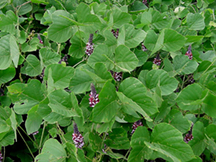
April 25, 2005
Kudzu turning over new leaves in Indiana counties
WEST LAFAYETTE, Ind. - A leafy plant blanketing much of the South is slowly pulling the covers over Indiana.

|
Kudzu, known for its green quilt-like growth pattern, has been confirmed in more than 20 Indiana counties. The invasive plant species poses risks to both soybean growers and the forestry industry, said Glenn Nice, a Purdue Extension weed scientist.
"At the moment, there are well over 50 kudzu sites in Indiana," Nice said. "The sites are mostly in the southern part of the state, with one site as far north as LaPorte County."
Nice and Purdue Extension plant pathologists Greg Shaner and Steve Hallett recently visited Indiana kudzu sites to learn more about the plant that has attained near-celebrity status below the Mason-Dixon line.
"Kudzu is a very aggressive plant that, once it gets a hold somewhere, is very difficult to get rid of," Nice said. "It essentially blankets any plants in its path. It forms vines that climb trees. In forestry agriculture, kudzu can be a real problem."
Trees covered by kudzu can die from lack of sunlight or stress caused by the weight of the vines, Nice said.
Another concern is kudzu's connection to soybeans. Because it is a legume like the soybean plant, kudzu serves as an alternate host for Asian soybean rust - a devastating crop disease first detected in the continental United States this past November. The disease spread as far north as Missouri and Tennessee.
Kudzu's dense leaf area provides an ideal breeding ground for future soybean rust infection. The fungal pathogen produces spores that can be picked up by the wind and carried to other locations. So far this year, soybean rust spores have been found on kudzu leaves in three Florida counties.
Soybean rust needs living leaf tissue in order to reproduce and spread. Leaves on Indiana kudzu fall off in the winter, making it unlikely that Hoosier kudzu could host rust during the winter, Nice said. Kudzu in Dubois County was beginning to bud earlier this month, he said.
While soybean rust probably could not survive an Indiana winter, Hoosier kudzu could help launch new generations of rust spores during the soybean-growing season, Nice said.
"The general belief is that soybean rust will come up from the south, and it has to come up from the south because it cannot overwinter in Indiana," he said. "If soybean rust makes it into the state, kudzu may pose a problem in that rust also will infect kudzu here in Indiana. Kudzu could be a point of inoculum for further infection."
Kudzu can be controlled, but it isn't easy. Mature kudzu plants are the hardest to eliminate, Nice said.
"Certain herbicides work on this plant," he said. "Glyphosate tends to have activity, as does triclopyr and a few of the growth regulators for woody plants.
"However, the older a kudzu colony gets, the more difficult it is to control. Colonies that are over nine years old become almost impossible to control. The reason for this is that kudzu develops these incredible underground root structures. They dig deep and are dug in well enough to survive anything we try to do to them."
The Purdue kudzu research team and the Indiana Department of Natural Resources continue to monitor kudzu. A map of counties with confirmed and suspected kudzu sites is available on the Purdue Plant and Pest Diagnostic Laboratory's soybean rust Web site. To view the map, log onto https://www.ppdl.purdue.edu/ppdl/SBR/SBR_hosts.htm and scroll to the bottom of the page.
For more information about kudzu, read Purdue Extension publication BP-69-W, "Kudzu in Indiana," by Nice, Purdue weed scientists Tom Bauman and Bill Johnson, and Peggy Sellers, coordinator of Purdue's Master Gardener Program. The article can be downloaded online.
Writer: Steve Leer, (765) 494-8415, sleer@purdue.edu
Source: Glenn Nice, (765) 496-2121, gnice@purdue.edu
Ag Communications: (765) 494-2722;
Beth Forbes, forbes@purdue.edu
Agriculture News Page
Related Web site:
Purdue University Weed Science Page
PHOTO CAPTION:
Kudzu is an invasive species related to the soybean plant. (Purdue Extension photo/Chris Parker)
A publication-quality photo is available at https://www.purdue.edu/uns/images/+2005/nice-kudzu.jpg
To the News Service home page